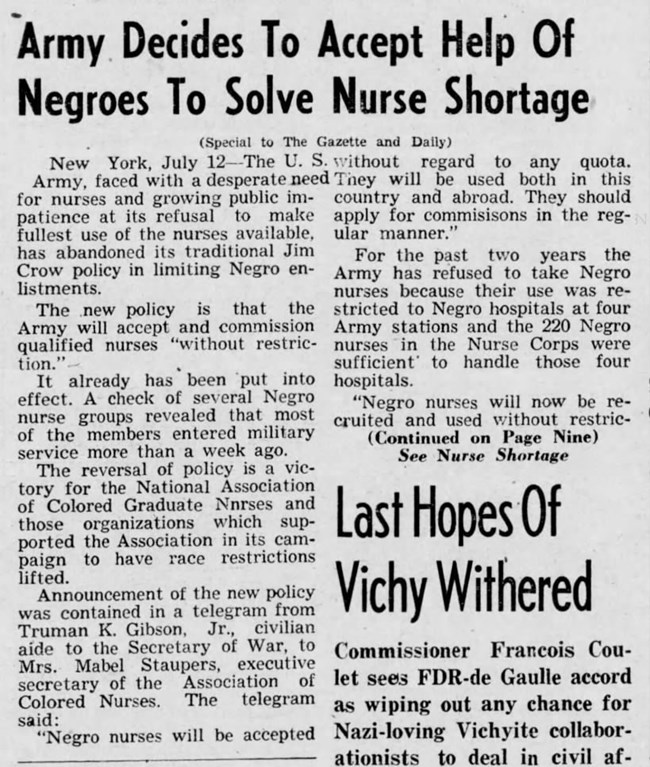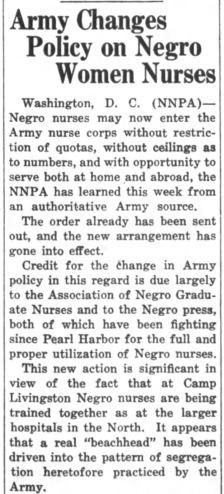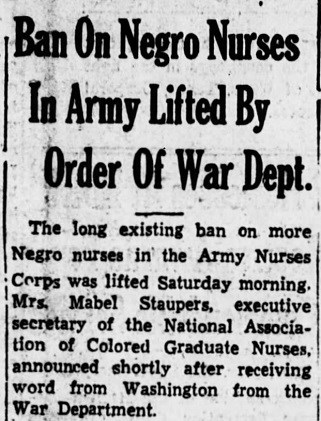Part of a series of articles titled Curiosity Kit: Mabel Keaton Staupers.
Previous: Places of Mabel Keaton Staupers
Article

Congratulating Spingarn winner. [Between 1950 and 1966] Photograph. Retrieved from the Library of Congress, <www.loc.gov/item/96514539/>.
Mabel Keaton Staupers fought for the integration of Black nurses through World War II. Born in Barbados in 1890, she immigrated with her family to Harlem in 1903. Staupers graduated with honors from Freedmen’s Hospital School of Nursing in Washington DC. Her primary focus was on serving her community. She recognized Tuberculosis as a threat to urban African Americans. Staupers worked for local health organizations to make sure there were enough resources to treat it. During this time, she also saw the impact of segregation on other Black nurses.
In 1934, the National Association of Graduate Colored Nurses (NAGCN) hired her as their first paid Executive Secretary. As Executive Secretary of NAGCN, she worked to get Black nurses access to equal education and working conditions. Her work increased during World War II. Military policies and quotas around nursing brought national attention to inequalities faced by African American women. Staupers wrote op-eds, lobbied Congress, and met with key public figures like Eleanor Roosevelt. By the end of the war, Staupers and the NAGCN helped integrate nurses in the military and in other federal programs, like the Cadet Nurse Corps. In 1948, the American Nursing Association (ANA) also fully integrated and the NAGCN dissolved. Staupers won the Springarn Medal from the NAACP for her work. She died in Washington DC in 1989.
Positive change in our society is the result of many people’s efforts. But the impacts of individuals and groups do not always get the recognition they deserve. Mabel Staupers and the NAGCN worked tirelessly to integrate nursing, especially during World War II. One of their major obstacles were the exclusion or quotas for Black nurses in the armed forces. After four years of speaking out, lobbying Congress and gathering testimony, the Navy Nurse Corps and the Army Nurse Corps lifted their restrictions on Black nurses.
Look at the following newspaper articles and consider the involvement of Staupers and the NAGCN more generally. Use the questions to guide your thinking about people’s ability to create change and how we credit them in our society.

The Gazette and Daily. (July 13, 1944). Newspapers.com. Retrieved September 19, 2023,
New York. July 12- The U. S. Army. faced with a desperate need for nurses and growing public impatience at its refusal to make fullest use of the nurses available, has abandoned its traditional Jim Crow policy in limiting Negro enlistments.
The new policy is that the Army will accept and commission qualified nurses "without restriction.”
It already has been put into effect. A check of several Negro nurse groups revealed that most of the members entered military service more than a week ago.
The reversal of policy is a victory for the National Association of Colored Graduate Nurses and those organizations which supported the Association in its campaign to have race restrictions lifted.
Announcement of the new policy was contained in a telegram from Truman K. Gibson Jr., a civilian aide to the Secretary of War, to Mrs. Mabel Staupers, executive secretary of the Association of Colored Nurses. The telegram said:
“Negro nurses will be accepted without regard to any quota. They will be used both in this country and abroad. They should apply for commissions in the regular manners.”
[Continued on pg. 9]…Mrs. Staupers said….
“Our organization is urging all qualified nurses to apply for admission to the Army Nurse Corps. They should apply through their local Red Cross chapter. There are 800 in the New York area ready to go.
“This policy change is a significant and progressive step in race relations. It shows that the War Department will respond to public pressure and demands. We wish to acknowledge the help of all the organizations that have assisted us, especially the National Nurses Council for War Services.” …
The Jim Crow policy on nurses was changed by the Army only after repeated and insistent appeals for white nurses had failed to fill quotas. Five thousand nurses are needed by the end of the year and, so far, recruitment drives have fallen below the quotas set.
While appeals to white nurses were being made by the Army, Negro nurses were making futile please to be accepted. Last October the Red Cross held a recruitment meeting for nurses at the Waldorf-Astoria. A number of Negro nurses were invited.
They said, after the meeting, that it “was simply heartbreaking” to hear the pleas for help and to realize that they who were ready and eager to aid, were barred by their color.”

St. Paul Recorder. (July 14, 1944). Newspapers.com. Retrieved September 19, 2023
What is Mabel Staupers and the National Association of Graduate Colored Nurse’s role in changing the military’s policy on African American nurses? How can you tell from the article?
Newspapers journalists often structure their stories to put the most important information first, then add the details. This is a based on two persuasive strategies of primacy (the most important point first) and repetition (the most important thing repeated.) Based on that organization, what is the most important thing the writer wanted you to learn from this paper? Can you make any inferences about how important Mabel Staupers is to the change in military policy based on where and how often she is mentioned in the article?
The article looks both forward and backwards. Now that Stauper’s goal of lifting the quota on African American nurses has been accomplished, what else is she and the NAGCN doing? Why do you think they are taking these additional actions?
One way for historians to see if information was widely agreed on at the time is to compare one source with others. Read two more newspaper articles and think about how much they agree that Mabel Staupers is important to increasing participation of African American nurses in World War II.
The long existing ban on more Negro nurses in the Army Nurses Corps was lifted Saturday morning. Mrs. Mabel Staupers, executive secretary of the National Association of Colored Graduate Nurses, announced shortly after receiving word from Washington from the War Department.
Negro nurses recently returned front duty in Liberia are being reactivated for overseas duty, Mr. Staupers also disclosed, and they will shortly be sent overseas along with other nurses who are being recruited to bring the strength up.
“This,” said Mrs. Staupers. "is the culmination of the fight for equal opportunities for nurses in the Army by the National Association of Colored Graduate Nurses, along with the cooperation of the National Nurses Council for War Service, the Joint Committee for Nurses in New York City, and other interested individuals and the national Negro Press.”
Although the War Department had for the last year been appealing for more nurses, it was at the same time refusing to accept the services of Negro nurses because the quota for Negro nurses had been filled. The lifting of the ban is expected to result in a large number of Negro nurses enlisting for service.
The New York Age. (July 15, 1944). "Staupers Nursing Victory" 3. Newspapers.com. Retrieved September 19, 2023, from https://www.newspapers.com/article/the-new-york-age-staupers-nursing-victor/132057947/
Washington, D. C. (NNPA) Negro nurses may now enter the Army nurse corps without restriction of quotas, without ceilings as to numbers, and with opportunity to serve both at home and abroad, the NNPA has learned this week from an authoritative Army source.
The order already has been sent out, and the new arrangement has gone into effect.
Credit for the Change in Army policy in this regard is due largely to the Association of Negro Graduate Nurses and to the Negro press, both of which have been fighting since Pearl Harbor for the full and proper utilization of Negro nurses.
…
The Navy, however, despite its announced need, has not made any move in that direction yet. The latest report of the American Red Cross showed the Navy Nurse Corps to be 1,800 nurses behind its quota set for July 1. Urgent appeals are being made for Navy nurses, but they must be “white.”
Nurses must volunteer their services, and Mrs. Mabel Staupers, head of the Association oof Negro Graduate Nurses, has expressed hope that there will be no lack of enlistments now that the doors have been pried open. Through her organization she is notifying all local war counsels of this latest move of the War Dept.
St. Paul Recorder. (July 14, 1944). "Staupers Nursing Victory" pg. 4. Newspapers.com. Retrieved September 19, 2023, from https://www.newspapers.com/article/st-paul-recorder-staupers-nursing-victo/132060100/

The New York Age. (July 15, 1944). Newspapers.com. Retrieved September 19, 2023,
What information about Staupers and NAGCN’s actions and influence were the same? What was different?
Where did the different articles mention Stauper’s role? Did it change the way you feel about the importance of her involvement?
What do all three articles tell us about the ability of a person or group of people to make a difference in big policy decisions?
Look through a recent issue of a local or national newspaper. What is one effort to make change that is covered? Who is featured and how does their impact compare with Mabel Staupers?
Mabel Staupers recognized that the best way to advocate for other Black nurses was by getting organized. When the American Nursing Association did not admit all Black nurses or work to end segregation, a group of Black nurses formed the National Association of Graduate Colored Nurses. Staupers was the executive secretary of first the Harlem Tuberculosis Association and then the NAGCN. In these positions, she helped organize people for shared goals, from the treatment of Tuberculosis in African American communities to the rights of African American Nurses. She had to work on a local and national level.
There are a lot of groups today that fight for different causes and to improve society at different levels. Think about something you think could be better in the world. Chances are there is a group that is working on that.
Do some research. Start at the organization’s website and then look at other connections they may have. Fill in the following organizer:
|
Name of Organization |
|
Mission Statement |
|
Who can be a member? |
|
How can people (members or non-members) participate? |
|
What are 2 major victories in the last few years? |
|
What is their most pressing issue? |
|
What are they doing to address this issue? |

"Answering call for volunteer nurses aides." 1943 Feb. Farm Security Administration - Office of War Information Photograph Collection (Library of Congress).
While Staupers and the NAGCN were covered by the press, Staupers also wrote articles and opinion pieces for newspapers to publish. This was one strategy Staupers used to gained public attention for the unfair treatment of African American nurses during World War II.
Think about an issue that is impacting your community. Plan and write an op-ed (an opinion editorial) to raise awareness. Typically this is 2-5 short paragraphs making your case to a wide audience. As you prepare, consider the following questions:
What is happening? Why is it unfair?
Who is affected by the issue? Is there anyone you can talk to and quote in the article?
Who has the power to make change? What can they do?
Below is an activity that can build on or be done to enhance Activity 3: Raising Awareness. It is more collaborative and need more time commitment over weeks or even months.
Important Note: This activity involves intergenerational collaboration in the community. When gathering people’s stories, trust and respect goes both ways. Staupers was a nurse herself and reached out through her professional network. In her situation, everyone shared a common struggle and knew one another’s position. Only reach out to people who you trust and who trust you. Please do this activity with a trusted adult, like a parent or a teacher, who can help support you with outreach.
Mabel Staupers understood the importance of compelling stories. When there was a call for nurses during World War II, many Black women were ready and able to serve. However, the US Army had a quota to limit the number of African American nurses who could serve. The Army gave the Black nurses who did enlist limited assignments in bad conditions. Staupers lobbied the Department of Defense and Congress to try to make change. She also met with important public figures like Eleanor Roosevelt. Before each meeting, she gathered the stories of African American nurses to support her argument about unequal opportunities and treatment. These testimonies provided emotional appeals to those making decisions.
Think about an issue that you think is unfair in your community. Does it affect you? Who else does it affect?
Identify people or groups the issue affects and gather stories. You can do this through a survey, advertising to ask people to send letters or having a special meeting to share in person. Have a format for sharing so that the information gets at each participant’s personal experience with the issue. Prepare some standard questions for your topic and format, whether a survey, an interview or a meeting.
Finally, think about how you will share this testimony in a way that is impactful and persuasive. Staupers passed the testimony on to people with more direct power to make decisions. She also helped them get published in the newspaper. When she achieved her goals, she wrote a history of nursing desegregation called No Time for Prejudice. In the book, she shared her own experience and the experience of others.
Write a story, a letter to the editor, or make a short documentary about the issue. Remember to base your narrative not only on your own experience but the experiences of others
Part of a series of articles titled Curiosity Kit: Mabel Keaton Staupers.
Previous: Places of Mabel Keaton Staupers
Last updated: November 6, 2023